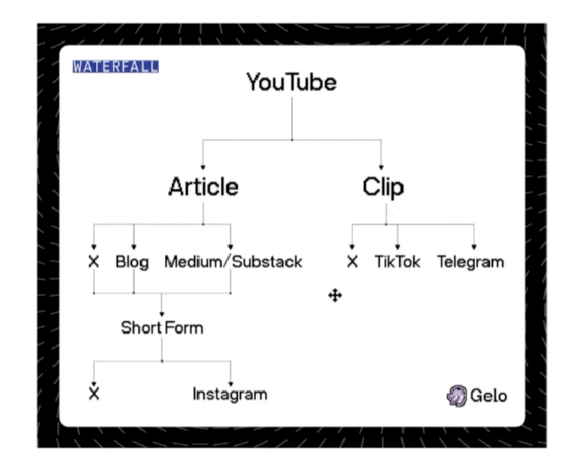How to Build a B2B Content Strategy That Converts in Web3

Most B2B crypto teams know content matters, but too many still treat it as an afterthought. Maybe you’ve published a few blog posts or spun up a newsletter, but it’s not driving meaningful growth. Or maybe you’ve got solid content, but it’s not aligned with your sales motion. Either way, without a structured approach, it’s hard to make content do real work for your business.
This post will walk you through how to build a B2B content engine that actually drives pipeline for your crypto startup. We’ll break down the types of content to create by buyer journey stage, how to align content with sales, and how to turn feedback into fuel for growth.
Why B2B content matters in crypto
Most B2B crypto startups sell infrastructure. Whether that’s developer tooling, analytics, APIs, node infrastructure, wallets, or security products. The reality is that these are complex products that require education, and the people buying them are not your average consumers. They’re other builders, teams, and enterprises who evaluate vendors based on clarity, capability, and credibility.
This is where a content strategy specifically designed for B2B businesses comes in.
Content helps you:
- Shorten the sales cycle by answering questions before the call
- Build trust with technical and non-technical buyers, pushing them down the funnel.
- Differentiate your product from similar tools
- Stay top-of-mind in long consideration cycles
In Web3, where many sales cycles are long and fragmented, content also plays a critical role in creating inbound momentum. It makes your brand easier to discover, easier to trust, and easier to buy from.
Matching content to the buyer journey
To build an effective content engine, it helps to map content to specific stages of the buyer journey and align it with the types of content you create. Here’s how that breaks down:
Awareness
Buyers at this stage don’t know you, or even that they have a problem. Your goal is to spark interest and build trust.
Focus on authority-building content that positions your team as a trusted voice in the space.
Examples:
- Market trend breakdowns (e.g., restaking, modular rollups)
- Myth-busting posts about your vertical
- “State of the industry” threads
- Podcasts or long-form interviews
- Opinionated takes on tech trends
- Top-of-funnel newsletters summarizing weekly or monthly shifts in your vertical
- SEO-focused articles
This content helps get you discovered and remembered. It shows prospects that you understand their world, even if they’re not ready to buy yet.
Consideration
At this point, the buyer is exploring solutions. They understand their problem and are looking at potential vendors.
Use product-aligned content to highlight how your solution works and how it compares to others in the space.
Examples:
- Light product walkthroughs or demos
- Buyer’s guides or ecosystem maps
- Case studies with relevant clients
- Demo request landing pages
This is where you help prospects self-qualify. They’re learning how your product fits into their stack, and whether it solves their problems better than the alternatives.
Decision
Now the buyer is getting close to making a choice. They’re talking to your team, reviewing docs, and weighing the tradeoffs.
Equip your team with sales support content to address objections and build confidence.
Examples:
- One-pagers summarizing product value
- Security audit summaries
- ROI benchmarks
- Technical architecture diagrams
- Decks tailored to different stakeholders
- Internal documentation to support legal or compliance teams
This content doesn’t have to live on your blog. Some of it may be internal or gated, but it should be easy to access and built with the sales team’s input.
The content waterfall (repurposing without burning out)
If you're a small team, the idea of creating content for every stage of the buyer journey might feel overwhelming. That's where smart repurposing comes in.
The content waterfall is a structured approach to repurposing content across your funnel without having to start from scratch every time. It’s a way to extract the full value out of every piece of work you produce.
Here’s an example of what we do with our own content:

So here’s how it works:
- Start with a high-leverage, long-form asset. This could be a research-backed blog post, an in-depth product teardown, or a founder interview.
- Break it down into modular components. Pull quotes, diagrams, case studies, benchmarks, or clips.
- Repurpose across formats. Create X threads, LinkedIn posts, infographics, pitch deck slides, demo scripts, or Telegram updates.
- Adapt to funnel stages. The same topic can be repurposed for awareness (e.g., a provocative take on X), consideration (e.g., a guide explaining how your product solves X), and decision (e.g., a case study about solving X for a real client).
This method:
- Reduces time to produce content
- Ensures message consistency
- Helps you stay visible with less effort
Crypto B2B teams often burn out trying to produce something new every week. With the waterfall method, one solid asset becomes a month’s worth of material and aligns content across marketing, sales, and community.
The content flywheel (aligning content with sales)
Great B2B content doesn’t live in a silo, it’s tightly aligned with your sales motion. When your sales and content teams share insights, you can build a content engine that actually drives revenue.

This creates a content feedback loop:
- Sales team identifies friction points: Common questions, concerns, and objections from prospects
- Content team turns those into assets: Blog posts, case studies, explainers, and visuals that address those concerns
- Sales team uses content to move deals forward: Sharing materials directly with prospects
- Performance is tracked and fed back: What assets get opened, clicked, or mentioned in follow-ups?
This loop helps:
- Shorten the sales cycle
- Improve close rates
- Inform what content to produce next
It also ensures that content is solving real problems, not just publishing for the sake of activity.
How to get started
If you're building a B2B content engine for your crypto startup, start small but intentional:
- Interview your sales or BD team: Identify the top questions they hear at each stage of the funnel. Ask them which pieces of content they already use, and which ones they wish they had.
- Talk to your customers: Ask what content helped them make a decision, what they needed but couldn’t find, and how they like to consume information (e.g., blog, video, docs).
- Audit your content assets: Look at what you’ve already published and tag each piece based on funnel stage, target persona, and content type. This will help surface gaps.
- Map content to your sales journey: For each key buyer stage, list out the must-have content that could help move someone closer to purchase. Prioritize by impact.
- Create one piece per stage: Start with one piece of high-leverage content per funnel stage. Don’t worry about volume, focus on getting the format, voice, and topic right. This might be a flagship blog post, a sales one-pager, or a strong integration guide.
- Assign ownership and create a simple workflow: Don’t overcomplicate. Use Notion, Airtable, or a Google Sheet to track content ideas, briefs, owners, and deadlines.
Once you’ve built this initial set of foundational content, it becomes easier to scale. You’ll have clarity on what content actually moves the needle and where to invest next.
Build once, distribute forever
If you’re in crypto and selling to other teams or businesses, content isn’t just a nice-to-have, it’s one of your biggest levers.
A good B2B content engine compounds. It builds authority, shortens sales cycles, and creates scalable assets that support growth over time. And creating great content is only half the battle.
Distribution is where the leverage lives. But distribution doesn't mean just tweeting a blog link once. It means turning one strong asset into a dozen tailored outputs across channels.
- Turn a long-form blog post into an X thread, a LinkedIn post, and a one-slide summary for pitch decks
- Break down product demos into short-form clips for Telegram and Discord
- Convert case studies into quote cards, integration diagrams, and ROI benchmarks
- Turn founder interviews into podcast clips and community newsletter features
This "build once, distribute forever" approach helps you:
- Maximize the value of every asset you create
- Reach different audiences in the formats they prefer
- Stay visible without burning out your team
Make sure to plan for distribution while you're creating the content. Build assets with distribution in mind from the beginning.
Want help designing a content engine that actually drives pipeline? DM us to book a strategy call.

